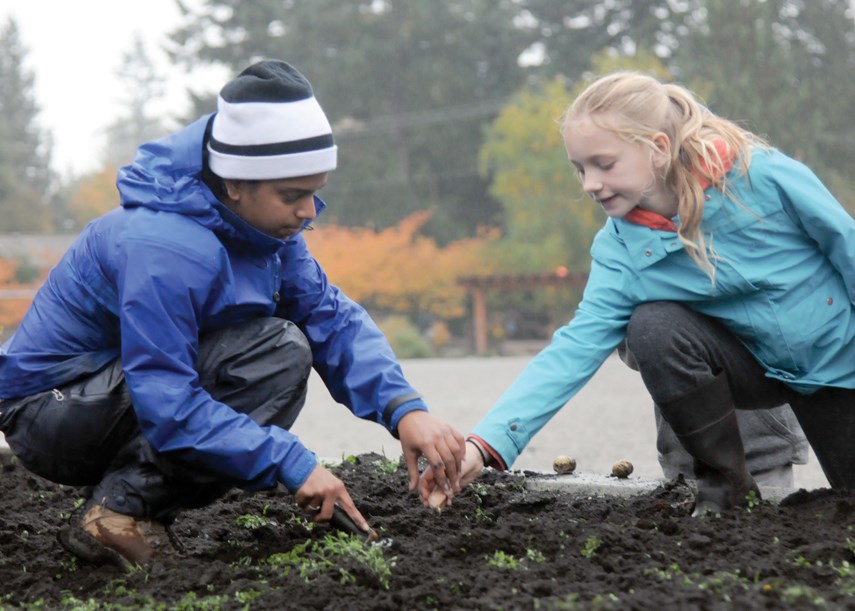He growls as he storms the country,
a villain big and bold.
And the trees all shake and shiver and quake,
as he robs them of their gold.
Steve Sabol, The Autumn Wind
You could teach students about the environment in a classroom.
A teacher could lead discussions and screen relevant documentaries. But somehow, it wouldn’t compare to walking outside and getting your hands dirty, says Thanushi Eagalle, education co-ordinator for the Edible Garden Project.
“One of the biggest things about the program is that it’s hands-on,” Eagalle says.
Those hands were a little damp Wednesday as autumn politely told summer it had overstayed its welcome. But beneath a sky filled with clouds the colour of water buffalos, Eagalle and Highlands Elementary students planted garlic, dug potatoes, and readied their garden bed ready for fall’s looming cold.
Farm to School BC had declared October to be Farm to School month, but for Eagalle, every month might as well be Farm to School month.
With a background in science, Eagalle’s career used to involve “staring into a microscope all day,” as she researched biodiversity, she reports. But by being sequestered in a lab, she found she was detached from community programs.
“I care about the environment and this is a really interesting way to talk about the environment and make it really fun. It’s so much fun to grow stuff,” she says.
She jumped at the chance to play a role with the Edible Garden Project.
There are some students, even in secondary schools, who have never planted anything in their life, she reports. It’s critical those students get a chance to see life as it blossoms.
“There is a value in watching something grow,” she says.
When students arrive for their 50 minutes in the garden, one of their first shops is to appraise the plants. Inevitably, they notice when a plant isn’t doing well. With that observation they wonder what they can do to take care of the plant. They feel responsibility, Eagalle explains.
That environment offers a chance to discuss “the plight of pollinators,” how to save seeds, how to avoid wasting food, and the importance of eating local food.
“They come out of it feeling almost like little activists in a sense that they’re doing something to help,” Eagalle says.
Rain or shine, Eagalle generally arrives at the garden by 8:30 a.m.
After a little bit of prep, kindergarten students, Grade 5 kids, and all classes in between file down for their turn on the soil.
“They love it,” she says. “I think one of the biggest draws is that they’re out of the classroom, which sometimes is also challenging.”
Kindergarteners have a tendency to lose attention, which means ensuring they always have something to do, Eagalle says.
For more mature students, Eagalle offers tips on planting and harvesting, as well as notes on “all the garden critters,” including pollinators and earthworms. Recently, she guided the students in a seed-saving lesson, as Highlands students collected radish seeds for next year.
“There’s always a theme with each visit,” she says.
For many students the best day is when they get to reap what they’ve sown. Sometimes they make a lavender sachet pillow, grill fresh garden vegetables, or eat a salad comprised entirely of ingredients they grew themselves.
Eating the salad is often a highlight, Eagalle explains.
Eagalle envisions the program spreading to more schools and more students.
“I would really love the program to evolve in a way that the teachers can come down and do the lessons without me,” she says, acknowledging it may be too much for a teacher to handle.
Growing your own food is way to “learn about and appreciate the environment,” Eagalle notes.
“I really hope that there will be a push for garden learning in all the schools in B.C.”



